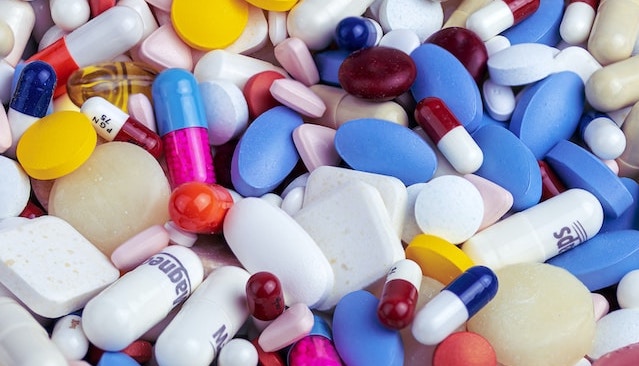Second, they can treat a host of serious mental conditions such as anxiety, PTSD, and postpartum depression. If you’re curious why Canada and the United States are in a rush to decriminalise magic mushrooms and truffles, this second reason is why. Psychedelics are a safer, cheaper, and often times more effective alternative to Big Pharma drugs. Who wants to burn a hole in their dang pockets just to afford antidepressants, when psilocybin can do the job just as well or even better?
Truth is, Big Pharma drugs still have their grip on a lot of folks. And when their negative side effects come to light, it’s always after the drug’s patent has run out. When the manufacturer has “milked the cash cow” so to speak. Now why is that? Why do these FDA warnings come too late? And are any of these “killer drugs” still around, wreaking havoc?
Read on to know the 7 Big Pharma drugs that will do more harm than good, and are better off flushed down the drain!
(P.s. what is ‘Big Pharma’ you ask? Big Pharma is the nickname given to the worlds largest and most successful pharmaceutical companies. In the US, where Big Pharma is its most powerful politically and economically, it is regularly voted one of the most hated industries.)
Insomnia Pills
Big Pharma’s biggest money-makers to date are insomnia pills. Perfect for the 21st centuries hustle culture, these tiny pills help us sleep after a caffeine-fueled workday. Ads for insomnia pills are on TV non stop — carefully placed for tired parents who can’t doze off. “For a good night’s sleep, ask your doctor about Ambien.” Sounds harmless when you hear it. But how exactly do pills like Ambien work on the sleeping brain?
Ambien (now known by its generic name zolpidem) is the top sleeping pill on the market. Made by Sanofi-Aventis, Ambien cashed in $2 billion a year before its patent expired in 2006. Ka-ching!
What started as a dream turned into a nightmare real quick. Users reported “acting crazy” during an Ambien blackout: driving while asleep, making phone calls, even snorting black shoe polish. Folks on a diet were horrified as they woke up to a half-eaten smorgasbord of pizza and ice cream. Things got so bad, Sanofi-Aventis even made new ads that told people to “stay in your bed” if they took Ambien.

In a study led by Dr. Daniel Kripke, they discovered that sleeping pill users had 4.6 times higher risk of death and cancer:
“What our study shows is that sleeping pills are hazardous to your health and might cause death by contributing to the occurrence of cancer, heart disease and other ailments.
“Nobody should be taking zolpidem at all because the side effects are so dangerous.”
Back in 2012, the Rochester Mayo clinic stopped giving Ambien to patients because they kept falling down — a side effect that used to happen *only* to the elderly. And in 2013, the FDA warned people about “Ambien hangovers” because the drug stayed in the body longer than intended. Yikes!
(Care to guess what happened in 2012 to Kerry Kennedy, daughter of Robert F. Kennedy? Ms. Kennedy told the cops that she took Ambien by accident, mistaken for a thyroid med. Right after she crashed into a tractor-trailer and drove away as if nothing happened…)
SSRI Antidepressants
Not only are SSRI antidepressants darn expensive, they’re also notorious for side effects such as nausea, weight gain, and a foggy, groggy mind. Yet one Big Pharma drug wins the dubious title of “Most Dangerous Antidepressant”… Paxil, made by GlaxoSmithKline (GSK). A 2015 study revealed that Paxil had buried a major side effect: record-high risk of suicide in teenage users. After taking Paxil, young adults were 6 times more likely to kill themselves. Even more disturbing? The U.S. chose Paxil for Iraq war veterans (a high-risk group for suicide), as a way of coping with PTSD.
The FDA also exposed how Paxil, when given to pregnant women, can cause their babies to have birth defects. To save face, Paxil placed a warning on their website, saying that babies may have “seizures, changing body temperature, feeding problems, vomiting, low blood sugar, floppiness, stiffness, tremor, shakiness, irritability or constant crying”. And so GSK ran from the issue. Right after they made a massive $2.12 billion from Paxil, of course!
Stimulants for ADHD
Ah, Adderall. The Student’s Saviour — or is it? Originally meant for kids diagnosed with ADHD, Adderall has morphed into a campus rockstar. The stimulant to score while you cram for a test. Plus, it’s not even that hard to get. Says the New York Times, ADHD is now the second most common diagnosis in kids (right behind asthma). Doctors prescribe Adderall as a cure for “forgetfulness and poor grades”, often in large doses. Thanks to Big Pharma, parents are okay with it. Thus the evil side effects get swept under the rug.

In 2009, a study in the American Journal of Psychiatry found that stimulants for ADHD — namely Adderall and Ritalin — caused 564 cases of sudden death in kids and young adults, from ages 7 to 19:
“…a significant association of stimulant use with sudden unexplained death emerged from the primary analysis.”
Believe it or not, Big Pharma paid off doctors to dispute the study, and say that Adderall was “safe”… Even safe enough for driving! (Yeah, right.) Let’s be honest. Who are you gonna believe at this point?
The Purple Pill
This next pill looks pretty, but don’t be fooled. Nexium, also known as the Purple Pill, is one of the deadliest drugs on the planet. As a proton-pump inhibitor, Nexium is taken if you get heartburn or indigestion from eating too much. Y’all know the feeling during the holidays! These days, however, Big Pharma “upgraded” indigestion into a disease called GERD (gastroesophageal reflux disease). PPIs such as Nexium are the only drugs that can treat it, or so they claim.
In one year alone, Nexium made almost $5 billion in the United States…and PPIs as a whole made $13.5 billion. Here’s the catch. In 2012, the FDA exposed Nexium and other PPIs as the root cause of Clostridium Difficile, a nasty infection in your gut that cannot be cured easily by antibiotics.
A 2013 Bone study also revealed how PPIs can cause bone fractures, pneumonia, and a severe lack of calcium. Makes you rethink that “All-you-can-eat” buffet, huh?
Statin Drugs
Behold Lipitor: the best-selling Big Pharma drug ever made. This Pfizer pill has raked in $125 billion in 14 years — or almost $11 billion in one year alone. So how the heck did Lipitor make so much money? Let’s go back in time, shall we!
Lipitor was first sold in 1997. This is when Big Pharma stopped relying on doctors, and began to advertise directly to the consumer via TV ads: “Ask your doctor about…” Folks were afraid of heart attacks caused by cholesterol, but no one was willing to stop eating cheeseburgers.
The solution? Statin drugs such as Lipitor, which lower your cholesterol. (Basically, you can now eat all the fatty foods you want. Just take a Lipitor after.) Next, Pfizer agents visited clinics with FREE samples of Lipitor, and even treated the doctors to lunch. Aaand what do you know, it worked. Soon, doctors prescribed Lipitor to more than 29 million people. Sales were at an all-time high, and so the Pfizer suits lived like kings.
Flash forward to 2012. The FDA sent out a warning on statin drugs, especially Lipitor. Turns out, these demon drugs can cause “diabetes, liver injury, muscle damage, and memory loss”. So much for the cheeseburger safety net!
Bisphosphonates
Fosamax was the first of a new class of drugs called bisphosphonates, which claimed to help stop bone loss (i.e. maintain strong and healthy bones). Made by Merck, Fosamax was well-liked by the elderly because it was dirt cheap. By the time these poor folks realised at what cost, it was too late. When Fosamax’s patent ran out in 2008, its side effects went public for the very first time. There was a LOT: heart problems, jawbone death, drug-resistant pain, bone fractures, esophageal cancer.
It’s not like an “oops, we didn’t know” situation, either. Merck scientists knew that Fosamax caused jawbone death since the freakin’ 1970s, back when they tested it on animals. And yet they still chose to keep it a secret.
Super Aspirin
Remember when Caitlyn won her first Olympic gold medal as Bruce Jenner? The athlete was a major endorser of the “super aspirin” drug called Vioxx, made by Merck. The pill claimed to treat maladies of all sorts: from menstrual cramps, to arthritis agony. Vioxx was like the new aspirin, but better ‘coz you never got gastrointestinal issues. Everyone and their mother loved Vioxx. Why not? ‘Twas a wonder drug!
No wonder it came as a shock when Vioxx ended up causing 27,785 heart attacks. Even users with no family history of them were suddenly at risk of cardiac events. So in 2006, the New England Journal of Medicine blamed Merck for hiding “critical data on an array of adverse cardiovascular events” from taking Vioxx. It was an absolute scandal.
Due to the uproar, Merck paid $4.85 billion to patients and survivors’ families. A mere drop in the bucket, I might add. Less than a year of Merck’s profits in fact. For five years, Vioxx was their crown jewel: earning them no less than $2.5 billion per year.
So now you’re wondering how Big Pharma manages to sleep at night? Well, you’re certainly not the only one…
Magic to the Rescue

There you have it. The list of Big Pharma drugs whose risks came out in public too little, too late. Positively mind-boggling! If a medicine you took six years ago might’ve given you heart problems, why didn’t the FDA warn you then? Why give a stamp of approval on literal “killer drugs” to begin with? As for the companies, of course they knew of the risks beforehand. They just kept silent for the sake of profit.
If you’re done with Big Pharma, and are looking for the newest revelation in healthcare, look no further than psychedelics. They’re the absolute best. Take psilocybin — the hallucinogenic compound in magic mushrooms and truffles. Psychonauts love it for its trippy qualities, the vivid colours and sounds it causes. But did you know that it can also can treat all kinds of mental conditions and raise your level of consciousness? ‘Tis true! Psilocybin guides you on a spiritual journey…one that reaches far beyond space and time..





